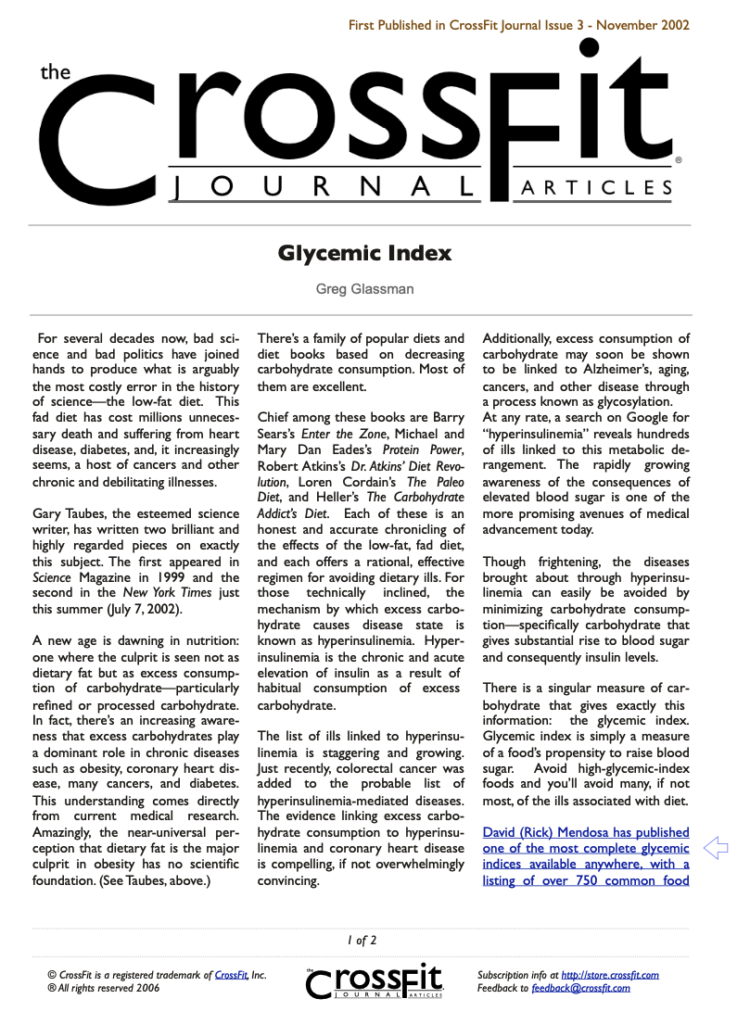For several decades now, bad science and bad politics have joined hands to produce what is arguably the most costly error in the history of science—the low-fat diet. This fad diet has cost millions unnecessary death and suffering from heart disease, diabetes, and, it increasingly seems, a host of cancers and other chronic and debilitating illnesses. Gary Taubes, the esteemed science writer, has written two brilliant and highly regarded pieces on exactly this subject. The first appeared in Science Magazine in 1999 and the second in the New York Times just this summer (July 7, 2002).
A new age is dawning in nutrition: one where the culprit is seen not as dietary fat but as excess consumption of carbohydrate—particularly refined or processed carbohydrate. In fact, there’s an increasing awareness that excess carbohydrates play a dominant role in chronic diseases such as obesity, coronary heart disease, many cancers, and diabetes. This understanding comes directly from current medical research. Amazingly, the near-universal perception that dietary fat is the major culprit in obesity has no scientific foundation. (See Taubes, above.)
There’s a family of popular diets and diet books based on decreasing carbohydrate consumption. Most of them are excellent. Chief among these books are Barry Sears’s Enter the Zone, Michael and Mary Dan Eades’s Protein Power, Robert Atkins’s Dr. Atkins’ Diet Revolution, Loren Cordain’s The Paleo Diet, and Heller’s The Carbohydrate Addict’s Diet. Each of these is an honest and accurate chronicling of the effects of the low-fat, fad diet, and each offers a rational, effective regimen for avoiding dietary ills.
For those technically inclined, the mechanism by which excess carbohydrate causes disease state is known as hyperinsulinemia. Hyperinsulinemia is the chronic and acute elevation of insulin as a result of habitual consumption of excess carbohydrate. The list of ills linked to hyperinsulinemia is staggering and growing. Just recently, colorectal cancer was added to the probable list of hyperinsulinemia-mediated diseases. The evidence linking excess carbohydrate consumption to hyperinsulinemia and coronary heart disease is compelling, if not overwhelmingly convincing.
Additionally, excess consumption of carbohydrate may soon be shown to be linked to Alzheimer’s, aging, cancers, and other diseases through a process known as glycosylation. At any rate, a search on Google for “hyperinsulinemia” reveals hundreds of ills linked to this metabolic derangement. The rapidly growing awareness of the consequences of elevated blood sugar is one of the more promising avenues of medical advancement today.
Though frightening, the diseases brought about through hyperinsulinemia can easily be avoided by minimizing carbohydrate consumption—specifically carbohydrate that gives substantial rise to blood sugar and consequently insulin levels. There is a singular measure of carbohydrate that gives exactly this information: the glycemic index. Glycemic index is simply a measure of a food’s propensity to raise blood sugar. Avoid high-glycemic-index foods and you’ll avoid many, if not most, of the ills associated with diet. David (Rick) Mendosa has published one of the most complete glycemic indices available anywhere, with a listing of over 750 common food items giving values based on glucose’s score of 100.
We can increase the ease and utility of such a list by dividing commonly eaten foods into two groups—one of high-glycemic foods, “bad foods,” and one of low-glycemic foods, or “good” foods. This is the rationale behind the CrossFit Shopping List.

You may notice that the “good” foods are typically meats, vegetables, fruits, nuts, and seeds, whereas the bad foods include many manmade or processed foodstuffs. There are some notable exceptions, but the trend is certainly instructive.
High-glycemic, or “bad foods,” are typically starchy, sweet, or processed foods such as bread, pasta, rice, potato, grains, and desserts. More than a few observers have pointed out that low-glycemic foods have limited shelf life and are found on the perimeter of the grocery store, whereas high-glycemic foods have a longer shelf life and are typically found within the grocery store’s aisles.
Though this approach is an oversimplification of much of nutritional science, it has the power to deliver nearly all of the benefits offered by more detailed and elaborate regimens such as those by Sears, the Eadeses, Cordain, Atkins, and the Hellers. Eat more of the “good” foods and less of the “bad” ones and you’ll garner much of what the more responsible eating plans offer.
Many of our friends and clients have radically transformed their health through this single tool.
This article, by BSI’s co-founder, was originally published in The CrossFit Journal. While Greg Glassman no longer owns CrossFit Inc., his writings and ideas revolutionized the world of fitness, and are reproduced here.
Coach Glassman named his training methodology ‘CrossFit,’ which became a trademarked term owned by CrossFit Inc. In order to preserve his writings in their original form, references to ‘CrossFit’ remain in this article.
Download a pdf of the original article HERE.
Greg Glassman founded CrossFit, a fitness revolution. Under Glassman’s leadership there were around 4 million CrossFitters, 300,000 CrossFit coaches and 15,000 physical locations, known as affiliates, where his prescribed methodology: constantly varied functional movements executed at high intensity, were practiced daily. CrossFit became known as the solution to the world’s greatest problem, chronic illness.
In 2002, he became the first person in exercise physiology to apply a scientific definition to the word fitness. As the son of an aerospace engineer, Glassman learned the principles of science at a young age. Through observations, experimentation, testing, and retesting, Glassman created a program that brought unprecedented results to his clients. He shared his methodology with the world through The CrossFit Journal and in-person seminars. Harvard Business School proclaimed that CrossFit was the world’s fastest growing business.
The business, which challenged conventional business models and financially upset the health and wellness industry, brought plenty of negative attention to Glassman and CrossFit. The company’s low carbohydrate nutrition prescription threatened the sugar industry and led to a series of lawsuits after a peer-reviewed journal falsified data claiming Glassman’s methodology caused injuries. A federal judge called it the biggest case of scientific misconduct and fraud she’d seen in all her years on the bench. After this experience Glassman developed a deep interest in the corruption of modern science for private interests. He launched CrossFit Health which mobilized 20,000 doctors who knew from their experiences with CrossFit that Glassman’s methodology prevented and cured chronic diseases. Glassman networked the doctors, exposed them to researchers in a variety of fields and encouraged them to work together and further support efforts to expose the problems in medicine and work together on preventative measures.
In 2020, Greg sold CrossFit and focused his attention on the broader issues in modern science. He’d learned from his experience in fitness that areas of study without definitions, without ways of measuring and replicating results are ripe for corruption and manipulation.
The Broken Science Initiative, aims to expose and equip anyone interested with the tools to protect themself from the ills of modern medicine and broken science at-large.
Support the Broken Science Initiative.
Subscribe today →
One Comment
Leave A Comment
You must be logged in to post a comment.
recent posts
The Daley Fix | Introducing MetFix Spark
A low-carb holiday table that still feels like Thanksgiving.





This stuff is awesome!!!